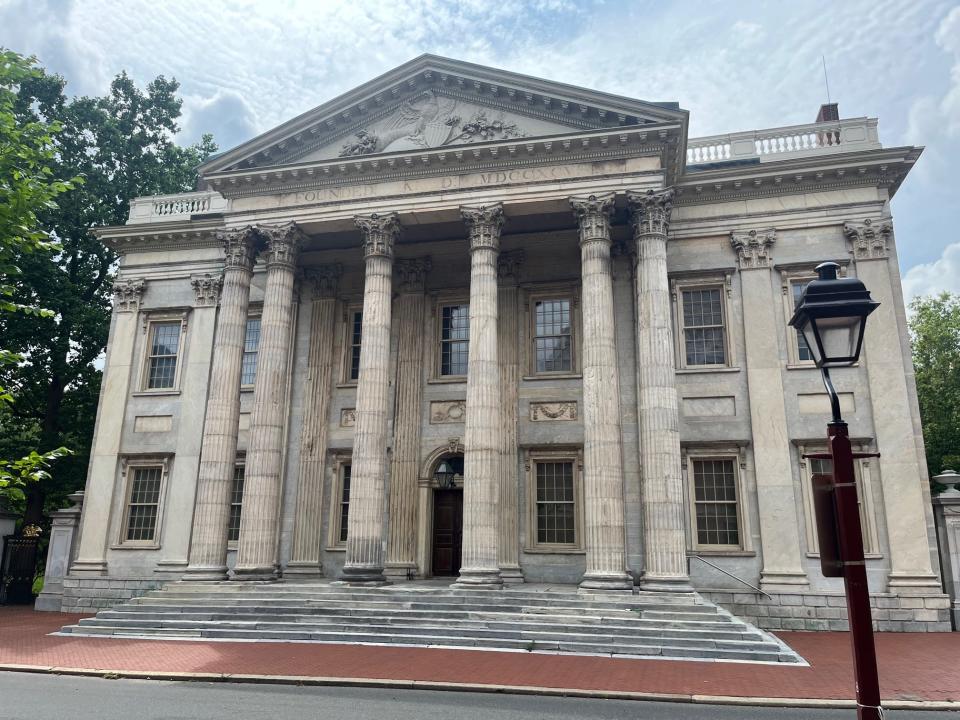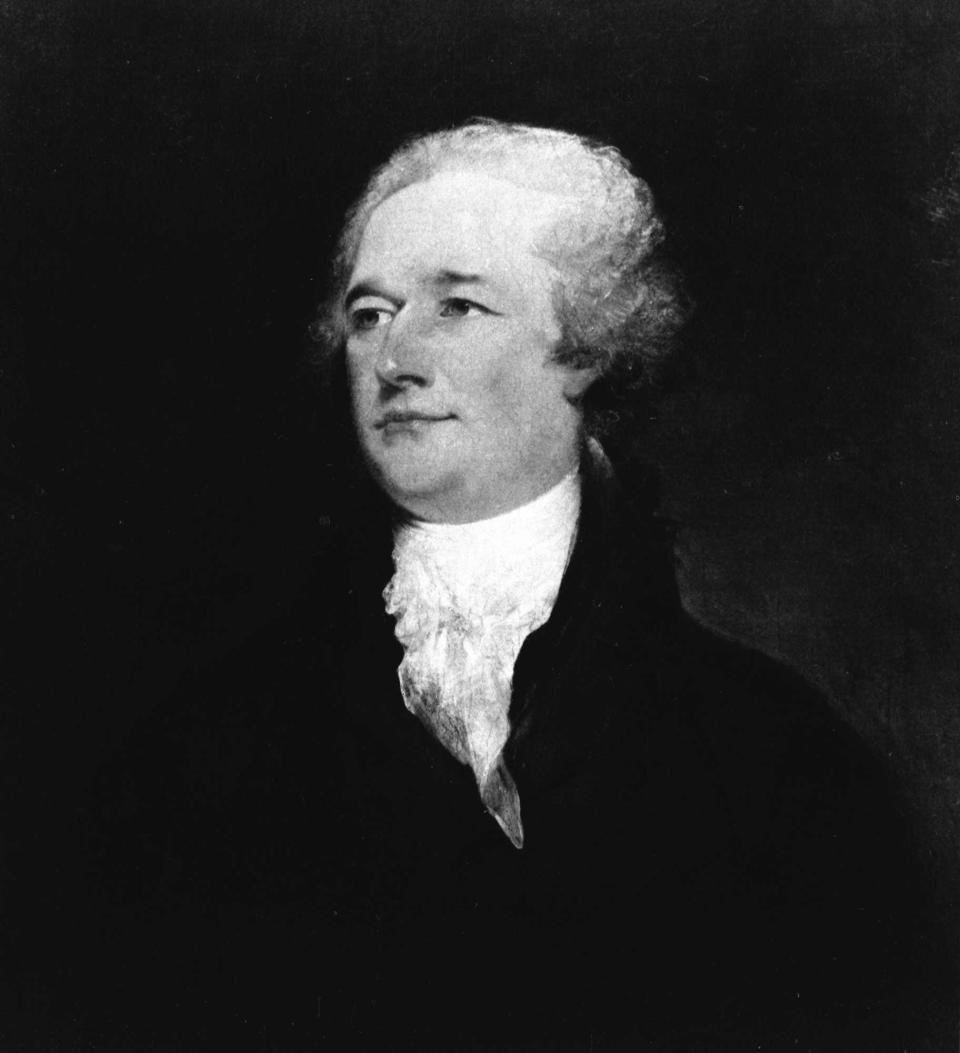Hamilton fans rejoice: The national bank he conceived will become a museum in Philadelphia
Fans of Alexander Hamilton will soon have a new place of pilgrimage in Philadelphia.
Though Philly is best known as the laboratory for American independence, it was also arguably where the American economy was born.
Off Chestnut Street just blocks from Independence Hall, the First Bank of the United States was our country's first truly national bank, an imposing Parthenon of neoclassical columns that still stands.
The bank was among the dearest dreams of then-Secretary of the Treasury Hamilton, and the bane of states-rights proponent Thomas Jefferson.
"The world we live in is a product of a strong economy created by Hamilton," wrote financial historian David Cowen. "The First Bank was instrumental in unifying the national economy and was a springboard to an era of manufacturing."

But the historic First Bank building at 120 S. Third St. has been closed off to the public for most of a century, until now.
This month, Independence National Historical Park will break ground on a $22 million restoration and renovation of the bank into a museum devoted to the birth of the American economy. The First Bank Museum will be open in time for the country's 250th birthday in 2026, park officials say.
First Bank of United States restoration has been a long time coming
The First Bank Museum will mark a return to prominence for a history that had long since fallen into obscurity.
These days the bank's imposing columns are best known to locals as a backdrop to countless wedding pictures — a metaphor, perhaps, for the cost of each ceremony.
But in 1790, the First Bank was the center of a raging debate about the future of the new country.
At the time, each state might have its own bank, bank crises were rampant, and a previous attempt at a national bank had dissolved into controversy. It's not clear that New York banks trusted Boston, or vice versa. So a dollar in one state wasn't necessarily worth a dollar in another.
"The story goes, a shopkeeper from Philadelphia travels to Baltimore, and they have a bank note for the bank of Pennsylvania," said Jonathan Burton, director of development at the Independence Historical Trust, which raised funds for the museum. "They take it down to Baltimore, where they're getting 80 cents on the dollar, because they don't know the solvency of the Bank of Pennsylvania."

The First Bank was Hamilton's solution: A national bank with branches in multiple states would be a stable source of credit, a means of financing war debt and a way to displace foreign coins with national coinage.
Jefferson fought against it, arguing the Constitution didn't offer authority for the novel federal institution. But Hamilton prevailed, and the bank in 1791 became one of the first major projects of George Washington's presidency.“Our first central bank was the centerpiece of Alexander Hamilton’s financial system. … It was(his) fond hope that the bank would expand the money supply, extend credit to government andbusiness, collect revenues, make debt payments, handle foreign exchange, and provide a depository forgovernment fund,” wrote historian Ron Chernow.
The bank's charter lasted just 20 years, and the intervening financial history is tumultuous. But the First Bank provided a template for both the national economy, historians argue, and bank architecture for years to come.
After closing in 1811, the First Bank fell into the private hands of Philadelphia banker Stephen Girard and other banks, then finally came to the National Park Service in 1855. Plan after plan to turn the landmark bank into a public attraction ran aground. Most recently, the Park Service used the building as an administrative office.
The turnaround came during the pandemic. The Historical Trust had already raised funds to create a proposal for a First Bank Museum, but so far lacked funds to construct it. In 2020, President Trump signed a stimulus bill called the Great American Outdoors Act, designed to help prop up park maintenance. With shovel-ready plans in hand, the First Bank was able to apply for funding.
In December 2022, President Biden signed his approval for $22 million to construct and renovate the First Bank Museum.
The First Bank Museum will be devoted to how the United States was able to succeed
The bank's historic neoclassical facade will remain unchanged except for minor renovations.
But John Milner Architects of Chadds Ford, Pennsylvania, has designed updates that include a modest addition to the side of the building home to an elevator, bathrooms and temperature control.
A floor-to-roof rotunda installed at the turn of the 20th century will also be fully renovated. The museum will be accessible through an entrance in the park behind the bank.Construction will likely be complete by the end of 2025, Burton said. The museum will still need to raise about $6 million to cover the cost of exhibits.
The museum plans interactive exhibits on the museum's inception by Hamilton, and the bank's role in funding westward expansion and the budding industrial economy. One area will be dedicated to the bank's practice of allowing enslaved people to be used as collateral for loans.
"In that way, the bank played a major role in the slave trade," Burton said.
Future exhibits might include a temporary show devoted to Alexander Hamilton, Burton said, a nod perhaps to a new generation of Hamilton fans inspired by Lin-Manuel Miranda's musical.
But especially, the First Bank Museum will help complete the story of the country's beginnings told at Philadelphia's Independence Mall, he said.Independence Hall and the Museum of the Revolutionary War show how the country became free from England. And the Constitution Center is about how the United States unified under common law. The First Bank, said Burton, will tell the story of how the nation thrived. And how it grew. "Our country didn't really take off until the bank bill was signed. The bank policies helped create the economy and help grow the nation into the world power that it is," he said. Matthew Korfhage is a Philadelphia-based reporter for USA Today Network.
This article originally appeared on USA TODAY NETWORK: First Bank of U.S., proposed by Hamilton, will be Philadelphia museum

